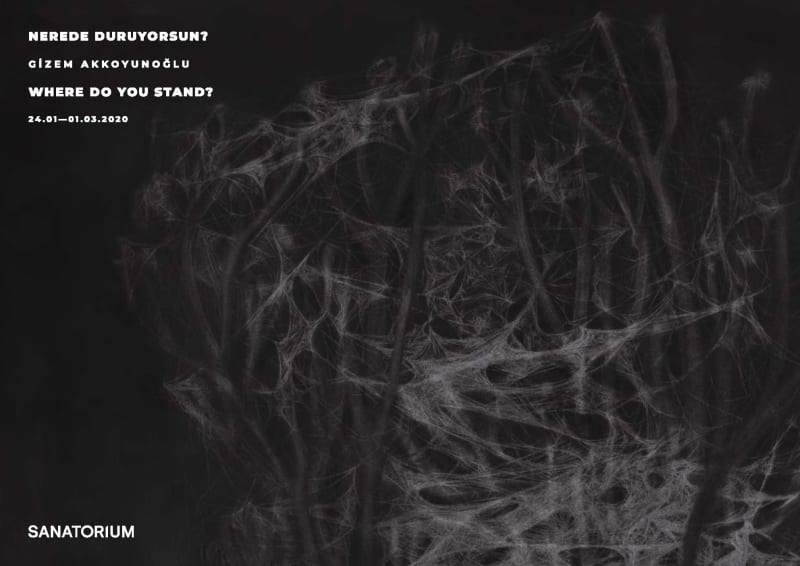Where Do You Stand?
Nursaç Sargon
“We carry what is not to be carried from below to above. We are the juices that rise secretly, not by force but sucked out of inertia and affixed to what is growing. We know the unknown ways and the inexplicable laws of living matter. We carry up what slumbers in the earthly, what is dead and yet enters into the living.”1
In her second solo exhibition entitled “Where Do You Stand?” to be held between January 24 – March 1, 2020 at SANATORIUM, Gizem Akkoyunoğlu treats the subject “purgatory” in which man has been being conceptually lost inside from past to present. The exhibition consisting of segments which render the human self unique aims at creating a space of confrontation with timeless elements that do not carry any geographical data.
Inspired by Casper David Friedrich’s work “The Abbey in the Oakwood”, Akkoyunoğlu creates her work featuring three dogs, reminiscent of the three-headed dog Cerberus which stand in front of the subterranean kingdom in Greek mythology in order to protect it. It is believed that this dog, the duty of which is to watch the gate, is inviting towards those who enter but shows its worst side to those who try to exit. The audience is met by three dogs which make one feel the deep darkness sensed when entering the exhibition venue after daylight. This encounter aims at provoking a feeling that we might be exiting while thinking that we are entering the place. Thus, following this entrance, we are included in the darkness when we start to think where we stand. When looking closely, there appears a jaguar walking in the forest. Known for its superior eyesight in the dark, this creature is a good observer as well as knows that when it should be visible. Directing us for exploring the parts that put us together by facing those in whose shades we continue our lives, the jaguar acts as a guide. In his book entitled “Death”, Todd May writes about the existence of the parts hidden in our memory of all of us that constitute our past although we do not particularly think about them. These parts constitute our self. The forest that extends to the earth, the underground and the sky; the jaguar that is visible between the trees that assumes the duty of being a passage between the worlds... They invite us to plumb the depths of our own layers.
Following the jaguar, we meet snakes the end of their heads and tails of which we cannot distinguish. Containing dualities in its nature, this animal is both the symbol of death and evil as well as rebirth. According to C.G. Jung, “the serpent is the earthly essence of man of which he is not conscious” and “has the weight of the earth in itself, but also its changeability and germination from which everything that becomes emerges.”2 Everything starts to illuminate at the point where one cannot breath and the darkness where one finds oneself slowly withdraws from its deep and dim blackness. Following the jaguar guiding one on one’s inner journey, one meets oneself in the snake. The truths where one is confined also symbolizes salvation.
The one who meets oneself seizes the opportunity to make one’s own way. Even if the spider is now invisible, its net is there. The one who is reborn is the one who attains the opportunity to plan one’s way anew.
The reborn birds are the next phase of the eggs which took place in the artist’s first solo exhibition in 2015. It is now the time of waking oneself up for the one who has descended to the gradual depths of darkness. This is a call for all the souls who pursue those descending to the underground and are trapped in the gateway.
Finally, one encounters descriptions of paradise and hell constructed with images from the world that we are living in. Hell contains landscapes from today’s nature where human has intervened, while paradise contains scenes of nature which has reseized power instead of all destruction. The gathering of the elements each belonging to this world presents a series of images from a fantastic world.
1 C.G. Jung, The Red Book, W.W. Norton & Company, p. 426
2 Jung, ibid., p. 180-181

